|
 Amanita australis Amanita australis
SynonymsOudemansiella macrospora
Limacella macrospora
Amanita excelsa
BiostatusPresent in region - Indigenous. Endemic
Images (click to enlarge)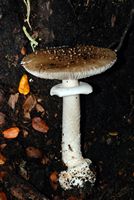
Owner: J.A. Cooper | 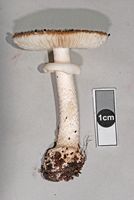
Owner: J.A. Cooper | 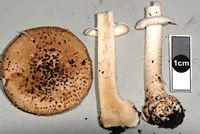
Owner: J.A. Cooper | 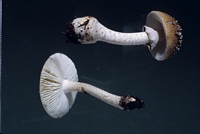
Owner: Herb. PDD | 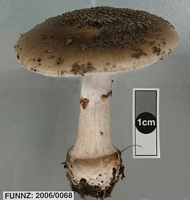
Caption: FUNNZ: 2006/0068, See public note for more information
Owner: FUNNZ | 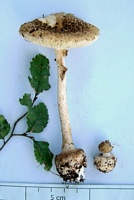
Owner: Karl Soop | 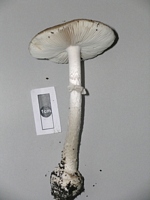
Owner: J.A. Cooper | 
Owner: J.A. Cooper | 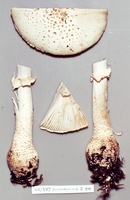
Caption: ZT68-197
Owner: E. Horak: © Creative Commons Attribution-Noncommercial 3.0 New Zealand | 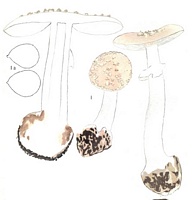
Caption: Plate 1: 1 Amanita australis, x 1; 1a, spores, x 2000
Owner: PDD | 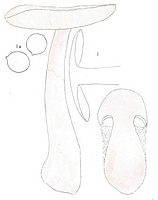
Caption: Plate 2: 1, Limacella macrospora, x 1; 1a, spores, X 2000
Owner: PDD |
Article: Ridley, G.S. (1991). The New Zealand species of Amanita (Fungi: Agaricales). Australian Systematic Botany 4(2): 325-354.
Description: Basidiocarps very small to medium, solitary or rarely gregarious. Pileus 20-90 mm wide, convex to piano-convex, then piano-depressed, margin occasionally splitting and rolling back to give a ragged appearance, disc dark buff, honey or isabelline, paling to buff at the margin, viscid when young or wet, drying with age, volva remnants forming conical to pyramidal warts aggregated on disc, becoming sparse and low towards the margin, at first white then greyish sepia or isabelline with white to buff tips. Lamellae crowded, free, 6-10 mm wide, white, margin entire; lamellulae truncate. Stipe 37-90 mm high, 6-26 mm diameter, narrowest at centre, hollow, from sub-bulbous to abruptly bulbous base, 14-38 mm diameter, surface above annulus white, floccose, below annulus white with white, buff or sordid transverse, striate bands, base with or without a rim of pulverulent, sordid buff to greyish sepia volva remnants. Annulus membranous, striate, white to buff, pendulous then adhering to stipe. Context of pileus white, occasionally pale isabelline under disc, rarely a grey line above lamellae, stipe white.
Spore print white. Basidiospores (367/31), (8-)9-12(-13-14.5) x (7-)8-10.5 µm, Qm 1.10, Q 1.00-1.33(-1.60), globose to ellipsoid, thin-walled, hyaline, amyloid. Basidia 43.5-76.5 x 10.5-17 µm, mostly 4-spored, clamped. Lamella margin cells numerous, 16-39.5 x 10.5-27.5 µm, globose, elliptic or clavate, hyaline. Pileipellis consisting of 220-270 µm wide, gelatinised suprapellis and non-gelatinised subpellis. Volva remnants on pileus consisting of abundant globose, clavate, napiform cells, 10-86 x 9-85 µm, pale umber to umber, in chains perpendicular to the pileus surface, becoming smaller and paler at tip of wart, subtended by moderately abundant hyphae, 4-10 µm wide, clamp connections abundant.
Article: Stevenson, G. (1962). The Agaricales of New Zealand: II. Kew Bulletin 16(1): 65–74.
Description: Pileus 6-9 cm. diam., buff coloured, darker at centre, moist, smooth,
thickly dotted with brownish-buff warts. Gills free, creamy-white, fairly
crowded. Stipe 1-2 x 4-9 cm. white, satiny, or with some cottony fibrils,
hollow; ring conspicuous, membranous; volva fused to a strongly bulbous
base. Spores amyloid, subglobose, 8 x 10-9 x 12um. Faint acid smell.
Habitat: rooting in Nothofagus litter at Lake Rotoiti, Nelson, 5.3.1955,
Stevenson.
Notes: This species is near to A. citrina but differs in having larger spores, and also in having more concrete numerous warts on the cap, rather than a few soft pieces of residual membrane
Article: Horak, E. (1971). A contribution towards the revision of the Agaricales (Fungi) from New Zealand. New Zealand Journal of Botany 9(3): 403-462 (http://www.rsnz.org/publish/abstracts.php).
Notes: Limacella macrospora Stevenson (26 D) = Oudemansiella macrospora
(Stevenson) comb. nov. (Basionym: L. macrospora Stevenson, Kew Bull. 16:
68, 1962)
A full description of this species will be published later.
Article: Ridley, G.S. (1993). Limacella macrospora Stevenson and L. wheroparaonea, a new species, from New Zealand (Fungi, Agaricales, Amanitaceae). Australian Systematic Botany 6: 155-159.
Description: Basidiospores (15/1), 9.5-10.5 x 8.5-9.5
µm, Qm 1.09, Q 1.05-1.1 l(-l.17), subglobose to broadly ellipsoid,
hyaline, amyloid. Basidia 47-53 x 11.5-16.5 µm, 4-spored, with clamp connections.
Lamella margin cells present but failed to reinflate. Acrophysalides present.
Notes: This specimen was badly decomposed when it
was dried and little microscopic detail has survived. The size, shape and amyloid
reaction of the spores, the dimensions of the basidia, the presence of clamp
connections and lamella margin cells indicate that this is Amanita australis
Stevenson and easily fits into the concept of this taxon (Ridley 1992).
Macroscopically the specimen lacks the typical pronounced basal bulb to the
stipe and volva remnants on the pileus; however, it is not an unknown condition
in this taxon. All the evidence indicates that A. macrospora Stev. is
a synonym of A. australis Stev.
Article: Stevenson, G. (1962). The Agaricales of New Zealand: II. Kew Bulletin 16(1): 65–74.
Description: Pileus 6-9 cm. diam., pale-fawn, moist, smooth, pellicle peeling; flesh white. Gills free, white, becoming pale yellow in older specimens, moderately crowded, long and short intercalated. Stipe 1-2 x 10-14 cm., pale fawn, floccose above ring, fibrillose below; ring of residual fibrils; veil of continuous cobwebby strands from cap edge to all lower parts of stipe. Spores arnyloid, globose, 7-8 x 8-~op. Pellicle of gelatinized hyphae. Strong sour smell.
Habitat: under Nothofagus at Day's Bay, Wellington, 7.6.1952, Stevenson.
Notes: The spores, amyloid in reaction and larger in size, distinguish this species from any of the previously described Limacellae
|